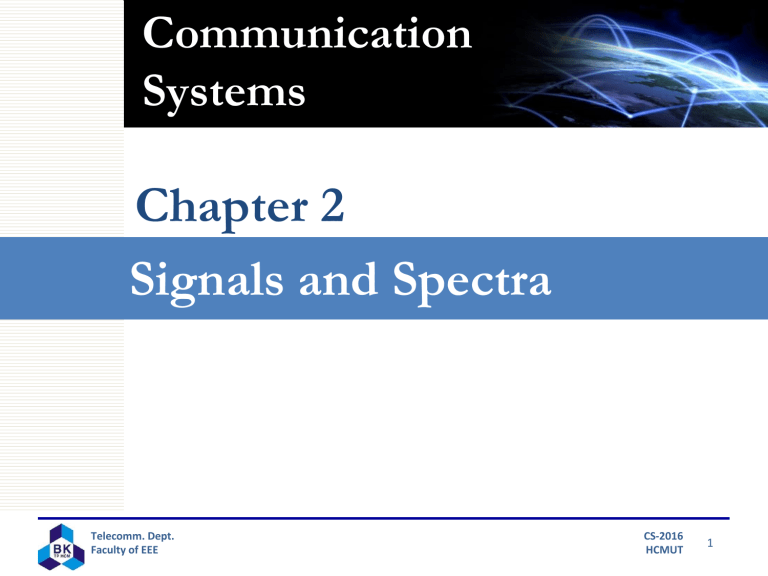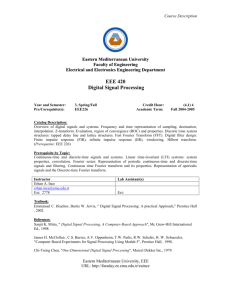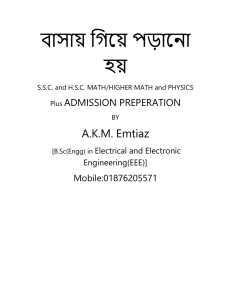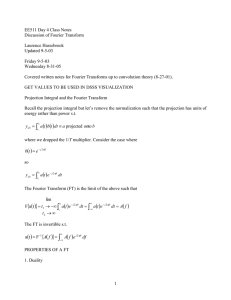
Communication Systems Chapter 2 Signals and Spectra Dr. Le Dang Quang Department of Telecommunications (113B3) Ho Chi Minh City University of Technology Email: ldquang@hcmut.edu.vn Telecomm. Dept. Faculty of EEE CS-2016 HCMUT 1 Chapter Outline 2.1 Line Spectra and Fourier Series 2.2 Fourier Transforms and Continuous Spectra 2.3 Convolution 2.4 Impulse and Transform in The Limit Telecomm. Dept. Faculty of EEE CS-2016 HCMUT 2 2.1 Line Spectra and Fourier Series Telecomm. Dept. Faculty of EEE CS-2016 HCMUT 3 Line Spectra and Fourier Series (1) In the frequency domain we view the signal as consisting of sinusoidal components at various frequencies. Sinusoidal signals Sinusoidal signals are modelled as 𝑣 𝑡 = 𝐴𝑐𝑜𝑠 𝜔0 𝑡 + Φ = 𝐴𝑐𝑜𝑠(2𝜋𝑓0 𝑡 + Φ) where A is the amplitude, ω0 is the angular frequency (f0 is the frequency) and is the phase. This is a periodic signal whose period is T0 = 2 / 0 = 1 / f0 Telecomm. Dept. Faculty of EEE 4 CS2016 HCMUT Line Spectra and Fourier Series (2) Spectra of sinusoidal signal The line spectrum associates a certain frequency to a particular amplitude and phase. The one-sided line spectrum of a sinusoidal signal is: The amplitude and phase spectrum have an impulse at f0. The essential parameters of the signal can be seen from the spectrum: frequency, amplitude, and phase. Telecomm. Dept. Faculty of EEE 5 CS2016 HCMUT Line Spectra and Fourier Series (3) Linear combination of sinusoidal signals w t = 7 − 10cos 40𝜋𝑡 − 60𝑜 + 4 sin(120𝜋𝑡) This can be rewritten in the form: 𝑤 𝑡 = 7 cos 2𝜋0𝑡 + 10 cos 2𝜋20𝑡 + 120𝑜 + 4 cos(2𝜋60𝑡 − 900 ) which can be utilized to plot the one-sided line spectrum as above. Telecomm. Dept. Faculty of EEE 6 CS2016 HCMUT Line Spectra and Fourier Series (4) The complex representation of sinusoidal signal Usually, the signals are real-valued. However, the concept of complex signals is a useful tool in telecommunication. Most of the cases can be handled by using real signals, however, the complex signals are widely used in spectral analysis. The following Euler's equations are often needed: On the other hand, sine and cosine are given by Telecomm. Dept. Faculty of EEE 7 CS2016 HCMUT Line Spectra and Fourier Series (5) Two-sided spectrum One-sided spectrum could be used for real signals. In the following, twosided spectrum is used because it allows to handle also complex signals. In the case of real signals, the two-sided spectrum is obtained by using the substitution: The two-sided spectrum for the previous example is shown as: Here, basis functions are complex exponential. Telecomm. Dept. Faculty of EEE 8 CS2016 HCMUT Line Spectra and Fourier Series (6) The phasor diagram for the two-sided spectrum of sinusoidal consists of two vectors whose phase and direction of rotation are reversed. The resultant vector is a real signal. Telecomm. Dept. Faculty of EEE 9 CS2016 HCMUT Line Spectra and Fourier Series (7) Periodic Signals The signal v(t) is periodic if where m is any integer. In this case, the signal can be constructed by combining signal segments of length T0: The length of the periodic signals is infinite, therefore, the signals in the practical system can not be strictly periodical. However, many finitelength signals in the practical systems correspond very accurately to the pure periodic signals. Telecomm. Dept. Faculty of EEE 10 CS2016 HCMUT Telecomm. Dept. Faculty of EEE CS2016 HCMUT Line Spectra and Fourier Series (8) Phasor representation A complex exponential function can be given as phasor which rotates around origin: Real signal corresponds to the real part of the phasor: Phasor representation is used to illustrate sinusoidal signals and communication signals consisting of sinusoidals. Telecomm. Dept. Faculty of EEE 12 CS2016 HCMUT Line Spectra and Fourier Series (8) Power and average of the periodic signals The average of a signal is: The average power of the periodic signal is: When 0< P < ∞, 𝑣(𝑡) is called a periodic power signal. Example: Telecomm. Dept. Faculty of EEE 13 CS2016 HCMUT Line Spectra and Fourier Series (9) Fourier-series A periodic signal can be written by using the exponential Fourier series where The complex coefficients cn can be expressed using the polar form: The exponential Fourier series determines the two-sided spectrum for a periodic signal. It consists of the harmonics (i.e., integer multiples) of the frequency f0. |cn| is the value of the amplitude spectrum at nf0 and argcn is the corresponding value of the phase spectrum Telecomm. Dept. Faculty of EEE 14 CS2016 HCMUT Line Spectra and Fourier Series (10) The properties of the line spectrum All frequencies are integer multiples (or harmonics) of the fundamental frequency f0 The DC component c0 equals the average value of the signal: If v(t) is real, then which means that the amplitude spectrum has even symmetry and the phase spectrum has odd symmetry and can be grouped into complex-conjugate pairs. Telecomm. Dept. Faculty of EEE 15 CS2016 HCMUT Line Spectra and Fourier Series (11) Sinc-function (sinus cardinalis - cardinal sine) The sinc-function is often needed in the spectral analysis: Telecomm. Dept. Faculty of EEE 16 CS2016 HCMUT Line Spectra and Fourier Series (12) Example: Rectangular pulse train The coefficients of the Fourier series can be calculated as follows: Telecomm. Dept. Faculty of EEE 17 CS2016 HCMUT Line Spectra and Fourier Series (13) Example: Rectangular pulse train (cont.) Below figures are amplitude and phase spectra in the case where τ / T0 = 1/4. The function sinc fτ can be recognized from the envelope of the amplitude spectrum. The amplitude of the DC component is c0= Aτ / T0. Telecomm. Dept. Faculty of EEE 18 CS2016 HCMUT Line Spectra and Fourier Series (14) Gibbs phenomenon If the periodic signal has a stepwise discontinuity (like in rectangular pulse train), the Fourier series does not converge at the points of discontinuity. The partial sum converges to the mid-point of the discontinuity. On each side of discontinuity, has oscillatory overshoot of about 9% independent of N (the number of terms). As N is increased, the oscillations collapse into nonvanishing spikes. Telecomm. Dept. Faculty of EEE 19 CS2016 HCMUT Line Spectra and Fourier Series (15) Telecomm. Dept. Faculty of EEE 20 CS2016 HCMUT Line Spectra and Fourier Series (16) Gibbs phenomenon has implications for the shapes of the filters used with real signals. An ideal filter that is shaped like a rectangular pulse will result in discontinuities in the spectrum that will lead to distortions in the time signal. Real applications use window shapes such as Hamming or Hanning windows. Telecomm. Dept. Faculty of EEE 21 CS2016 HCMUT Line Spectra and Fourier Series (17) Parseval's theorem Parseval's theorem relates the average power P of a periodic signal to its Fourier coefficients as follows: This means that the average power is the sum of the powers of the spectral components. Therefore, Parseval’s theorem implies superposition of average powers. Telecomm. Dept. Faculty of EEE 22 CS2016 HCMUT 2.2 Fourier Transforms and Continuous Spectra Telecomm. Dept. Faculty of EEE CS2016 HCMUT Fourier Transform and Continuous Spectra Nonperiodic signals Fourier series decomposition is only applicable to periodic functions. If a non periodic signal has finite total energy, its frequency-domain representation will be a continuous spectrum obtained from the Fourier transform. Telecomm. Dept. Faculty of EEE 24 CS2016 HCMUT Fourier Transform and Continuous Spectra Fourier transform and continuous spectra Consider signals whose energy: is finite. This also means that the signal is concentrated to relatively short time period (time-limited). The Fourier transform for this kind of energy signal is defined as V(f) is the spectrum of signal v(t). Periodic signals have line spectra (discontinous spectra); they can be developed in Fourier series. Non-periodic signals have continuous spectra => Fourier transform is used (instead of Fourier series). Telecomm. Dept. Faculty of EEE 25 CS2016 HCMUT Fourier Transform and Continuous Spectra The spectrum has the following properties: V(f) is a complex function. |V(f)| is the amplitude spectrum and argV(f) is the phase spectrum. The value of V(f) at f = 0 equals the net area of v(t): If v(t) is real => V( -f ) = V*( f ) (hermitian symmetry), i.e, The time function v(t) is obtained from V(f) by using the inverse Fourier transform: Telecomm. Dept. Faculty of EEE 26 CS2016 HCMUT Fourier Transform and Continuous Spectra Example: Rectangular pulse The notation Π(t / τ) is used for rectangular pulse. It is defined as Consider the signal v(t) = A Π(t / τ). Its Fourier transform is It can be seen that the spectrum of the rectangular pulse corresponds to the envelope of the spectrum of the rectangular pulse train (see the previous example). It can be also noted that most of the spectral content is located in the frequency band of f < 1/τ . This means that the spectrum of a narrow pulse is wide. Telecomm. Dept. Faculty of EEE 27 CS2016 HCMUT Fourier Transform and Continuous Spectra Telecomm. Dept. Faculty of EEE 28 CS2016 HCMUT Fourier Transform and Continuous Spectra Rayleigh's energy theorem Rayleigh's energy theorem is similar to Parseval's theorem (* is the complex conjugate) Thus, the energy of the signal can be calculated by integrating the square of the amplitude spectra. Example: The total energy of the rectangular pulse AΠ(t / τ) is E = A2τ. The energy in the frequency band f < 1/τ is This is about 90% of the total energy. Telecomm. Dept. Faculty of EEE 29 CS2016 HCMUT Fourier Transform and Continuous Spectra Left plot: rectangular pulse. Middle plot: Fourier transform of the rectangular pulse (sinc waveform). Right plot: squared Fourier transform (signal spectrum) and the energy distribution per frequency bands. Telecomm. Dept. Faculty of EEE 30 CS2016 HCMUT Fourier Transform and Continuous Spectra Fourier transform properties 1. Duality: if 𝑧 𝑡 = 𝑉 𝑡 , 𝑡ℎ𝑒𝑛 𝐹 𝑧 𝑡 = 𝑣 −𝑓 2. Superposition: σ 𝑎𝑘 𝑣𝑘 (𝑡) ↔ σ 𝑎𝑘 𝑉𝑘 (𝑓) 3. Time delay and scale change: 𝑣 𝑡 − 𝑡𝑑 ↔ 𝑉 𝑓 𝑒 −𝑗2𝜋𝑓𝑡𝑑 𝑣(𝛼𝑡) ↔ 4. Modulation: 𝑣 𝑡 cos 𝜔𝑐 𝑡 + Φ ↔ 5. Differentiation: 6. Integration: −∞ 𝑣 𝜆 𝑑𝜆 ↔ 𝑡 Telecomm. Dept. Faculty of EEE 𝑑 𝑣 𝑑𝑡 𝑒 𝑗Φ 𝑉 2 1 𝛼 𝑉 𝑓 𝛼 𝑓 − 𝑓𝑐 + 𝑒 −𝑗𝛷 𝑉 2 𝑓 + 𝑓𝑐 𝑡 ↔ 𝑗2𝜋𝑓𝑉 𝑓 1 𝑉 𝑗2𝜋𝑓 𝑓 31 CS2016 HCMUT 2.3 Convolution Telecomm. Dept. Faculty of EEE CS2016 HCMUT Convolution Convolution The convolution between two signal v(t) and w(t) is denoted by v∗w(t) and it is determined by Convolution has the following properties: Commutativity, associativity and distributivity Convolution is an essential concept when analyzing linear continuous-time systems. Telecomm. Dept. Faculty of EEE 33 CS2016 HCMUT Convolution Convolution and Fourier transform Convolution in time domain is equivalent to the multiplication in frequency domain Calculation of convolution Example: Telecomm. Dept. Faculty of EEE 34 CS2016 HCMUT Convolution Telecomm. Dept. Faculty of EEE 35 CS2016 HCMUT Convolution Result: Convolution is a smoothing operation. Telecomm. Dept. Faculty of EEE 36 CS2016 HCMUT 2.4 Impulse and Transform in The Limit Telecomm. Dept. Faculty of EEE CS2016 HCMUT Impulse and Transform in The Limit Impulses Up to now: a clear distinction between line spectra (that represent periodic signals) and continuous spectra (that represent non-periodic signals). Sometimes, a signal has both periodic and non-periodic terms → we introduce the concept of impulses in frequency domain for the representation of discrete frequency components. Useful tool: Dirac delta function (unit impulse). The unit impulse or the Dirac delta function δ(t) is defined as: Here v(t) is any ordinary function that is continuous at t = 0. If v(t) = 1: Telecomm. Dept. Faculty of EEE 38 CS2016 HCMUT Impulse and Transform in The Limit Graphical representation of the impulse: Aδ(t−td) Although an impulse does not exist physically, there are many conventional functions that have all the properties of the impulse as some parameter goes to zero. For example, a rectangular pulse having the amplitude of 1/ε and width of ε approaches an impulse waveform when ε approaches zero. Telecomm. Dept. Faculty of EEE 39 CS2016 HCMUT Impulse and Transform in The Limit The impulse has the properties: Impulse in the frequency domain Frequency-domain impulse corresponds to the spectra of constant and sinusoidal signals. The following transform pairs can be given: Telecomm. Dept. Faculty of EEE 40 CS2016 HCMUT Impulse and Transform in The Limit The spectra of the sinusoidal signals contains two impulses: If the Fourier series of the periodic signal is: Then its Fourier transform is: The above relationship connects the line spectrum of the periodic signals to the spectrum determined by the Fourier transform. See Example 2.5-1 in [1]. Telecomm. Dept. Faculty of EEE 41 CS2016 HCMUT Impulse and Transform in The Limit Impulses in the time domain The following transform pairs can be derived: The spectrum of the time-domain impulse contains all frequencies in equal proportion. This is physically impossible. However, there is some phenomenon where this model is valid up to very high frequencies. Step and sign-functions Step function is defined by Telecomm. Dept. Faculty of EEE 42 CS2016 HCMUT Impulse and Transform in The Limit Sign-function is defined by The time-Fourier transform pairs for these functions Telecomm. Dept. Faculty of EEE 43 CS2016 HCMUT Bài tập 1 Telecomm. Dept. Faculty of EEE CS2016 HCMUT 𝒆𝒋𝚽 𝒆−𝒋𝚽 𝒗 𝒕 𝐜𝐨𝐬 𝝎𝒄 𝒕 + 𝚽 ↔ 𝑽 𝒇 − 𝒇𝒄 + 𝑽 𝒇 + 𝒇𝒄 𝟐 𝟐 Telecomm. Dept. Faculty of EEE CS2016 HCMUT Telecomm. Dept. Faculty of EEE CS2016 HCMUT








